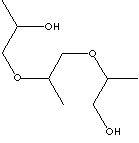|
TRIPROPYLENE GLYCOL |
||
|
PRODUCT IDENTIFICATION |
||
| CAS NO. |
24800-44-0 |
|
| EINECS NO. |
246-466-0 |
|
| FORMULA | H(OC3H6)3OH | |
| MOL WT. | 192.26 | |
| H.S. CODE | ||
|
SMILES |
byproduct of propylene glycol | |
|
TOXICITY |
Oral rat LD50: 10000 mg/kg | |
| SYNONYMS |
[(1-methyl-1,2-ethanediyl)bis(oxy)]bispropanol; TPG; |
|
| 2-(2-(2-Hydroxypropoxy)propoxy)-1-propanol; 1,1'-(propylenedioxy)di-2-Propanol; 1,1'-[(1-methyl-1,2-ethanediyl)bis(oxy)]bis-2-Propanol; [(Methylethylen)bis(oxy)] Dipropanol; [Mmetiletilen)bis(oxi)]dipropanol (Spanish); [(Méthyléthylène)bis(oxy)] Dipropanol (French); | ||
|
CLASSIFICATION |
||
|
PHYSICAL AND CHEMICAL PROPERTIES |
||
| PHYSICAL STATE | clear liquid | |
| MELTING POINT | -41 C | |
| BOILING POINT | 265 C | |
| SPECIFIC GRAVITY | 1.02 | |
| SOLUBILITY IN WATER |
miscible |
|
| pH |
|
|
| VAPOR DENSITY | ||
| AUTOIGNITION |
|
|
| NFPA RATINGS | Health: 0 Flammability: 1 Reactivity: 0 | |
|
REFRACTIVE INDEX |
1.4415 - 1.4425 |
|
| FLASH POINT |
141 C |
|
| STABILITY | Stable under ordinary conditions | |
|
APPLICATIONS |
||
Tripropylene
Glycol, distilled by hydrolysis of PO (Propylene oxide),
is a colourless, viscous, colorless liquid
featuring
low toxicity, low volatility, slow evaporation and
water miscibility. It and its ethers are not toxic and can be
used in food, soaps
and personal care products
as well as industrial applications such as;
|
||
| SALES SPECIFICATION | ||
|
APPEARANCE |
clear liquid | |
|
ASSAY |
99.0% min |
|
|
SPECIFIC GRAVITY |
1.015 -1.028 |
|
| DISTILLATION IBP |
263 C |
|
| DISTILLATION DP |
280 C |
|
|
COLOR, APHA |
40 max |
|
|
ACIDITY |
0.01% max |
|
|
WATERR |
0.2% max | |
| TRANSPORTATION | ||
| PACKING |
200kgs in drum |
|
| HAZARD CLASS | Not regulated | |
| UN NO. | ||
| OTHER INFORMATION | ||
| European Hazard Symbols: XI, Risk Phrases: 36/37/38, Safety Phrases: 26-36 | ||
|
GENERAL DESCRIPTION OF PROPYLENE GLYCOL |
||
|
Glycol: any of a class of organic chemicals characterized by having separate two
hydroxyl (-OH) groups, contribute to high water solubility, hygroscopicity and
reactivity with many organic compounds, on usually linear and aliphatic carbon
chain. The general formula is CnH2n(OH)2 or
(CH2)n(OH)2. The wider meaning names
include diols, dihydric alcohols, and dihydroxy alcohols. Polyethylene glycols
and polypropylene glycols are sometimes called polyglycols which are derived by
polymerization of ethylene oxide and propylene oxide respectively. Polyethylene
glycols are water-soluble at all molecular weights, but polypropylene glycols
become increasingly less water-soluble at high molecular weights. Mono-, di- and
tripropylene glycol, the first three members of a homologous series of propylene
glycol, are completely water and ethanol soluble; miscible with most organic
solvents including acetone, chloroform and some essential oils; soluble in 12
parts of ether. Propylene glycol is an odorless and colorless liquid; boiling
point 188 C, freezing point -39 C. Propylene glycol is prepared by hydrolysis of
propylene oxide. Large amount of propylene glycol is used in the plastics
industry for the manufacture of polyester fibers and alkyd resins. It is
used as a main ingredient in automobile antifreeze and engine-cooling liquids
and in brake and hydraulic fluids due to its useful properties of low freezing
point, involatility and low corrosive activity. It is used in the preparation of
body-care surfactants. Propylene glycol is replacing ethylene glycol and ethanol
as it is less toxic than ethylene glycol. Propylene glycol is described as a
"generally recognized as safe for use in food, cosmetics, and medicines" by
FDA. Propylene glycol USP grade is used as a non-toxic antifreeze in breweries
and dairies. It is used as a humectant in foods and cosmetics. It is used as a
solvent for colouring or flavouring agents as well as in many
oral, injectable or topical pharmaceuticals. Its
antibacterial property is applied in the preparation of sanitizing lotions.
|
||
